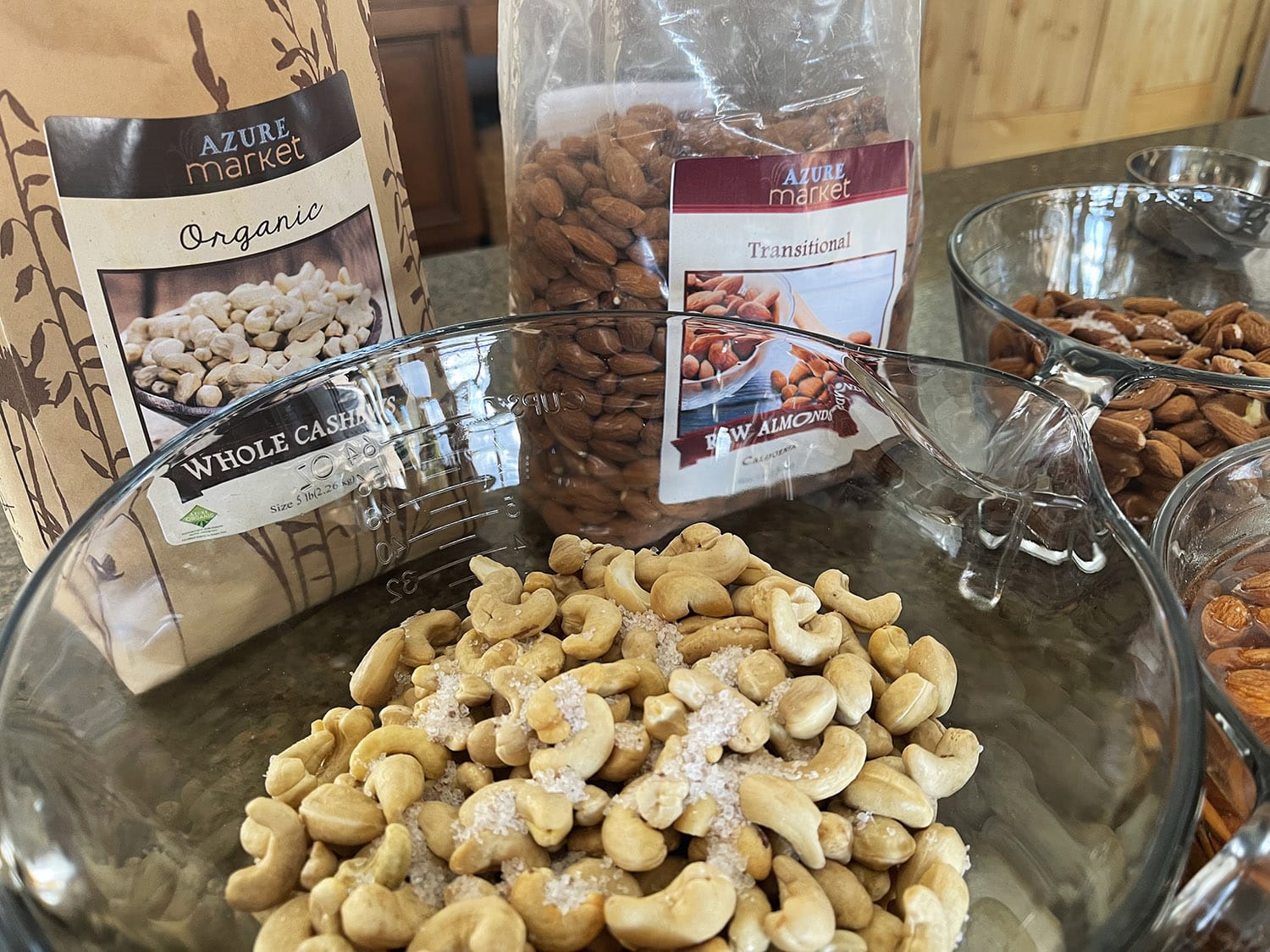Nuts and seeds are one category of food that almost everyone agrees on. Whether you’re on a vegetarian, vegan, low carb/keto, Mediterranean, paleo, Weston Price traditional foodie or just trying to focus more on *real* whole foods — you probably consider nuts and seeds to be a healthy snack and a great source of good fats, fiber, vitamins and minerals.
Unfortunately, you may not be getting the full benefits if the nuts/seeds are not prepared properly. Before our fast-food culture caught on, traditional cultures all over the world considered soaking, sprouting, fermenting and ‘activating’ a non-negotiable part of preparing grains, legumes, nuts and seeds.
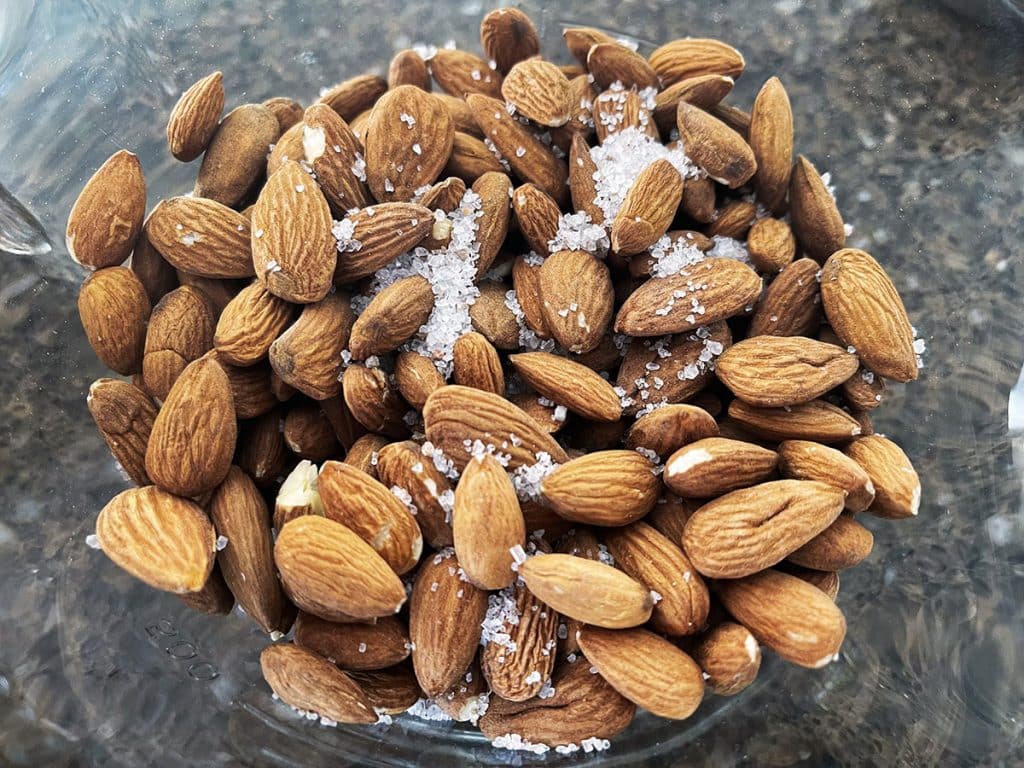
Consider that a plant’s prime directive in life is to survive to reproduce itself. From this perspective, it makes sense that nuts, seeds, grains and beans (all technically seeds) would be the most heavily defended part of the plant, since they’re basically plant babies and embody the plant’s ability to reproduce.
You can see this drive to reproduce played out in real time in most flowering plants. Take a blooming calendula for example. If you leave the flowers alone, they will go to seed and stop producing flowers after one round. Why? It fulfilled its purpose to reproduce. If you pinch off the blooms as they arrive, the plant will continue making flowers. It *needs* to get to the seed stage and will continue to try all season until it succeeds.
Most living things have defense mechanisms designed to ensure survival and reproduction. Animals have legs and sometimes teeth or armor to help fend off predators, but what about plants?
Nuts and seeds protect themselves by producing thick shells. The physical barrier is designed to protect the plant from pests, but they can also make the nut or seed very difficult to digest. You don’t normally eat a whole peanut, shell and all, (actually, I know people who do this) but most of us wouldn’t think twice about adding a bunch of flax, chia and hemp heart seeds to a green smoothie.
In his book The Carnivore Code, Dr. Paul Saladino suggests that since plants cannot run away from predators the way an animal can, they’ve developed their own multi-faceted defensive system that includes toxins that allow them to defend themselves against things that might want to eat them. These defensive compounds can range from bitter, unpleasant flavors to compounds that interfere with digestion or are downright toxic to animals — including humans.
Plants contain inhibitors to protect their seed babies from digestion and prevent germination until conditions are just right. Trypsin inhibitors interfere with the digestion of proteins and reduce the availability of essential amino acids in the diet. These compounds are designed to protect the seed or nut from predators by inhibiting the action of digestive enzymes (such as trypsin). Without these enzymes, the nut or seed cannot be broken down and absorbed, making them indigestible for predators.
Makes sense, doesn’t it? If a nut or seed can survive the digestive tract and make it out the other side, it may still be able to reproduce! 💩
Tannins help to protect nuts and seeds from pests and predators by making them taste bitter and unpalatable. They can also interfere with the absorption of iron and other minerals.
High levels of phytic acid naturally present in nuts and seeds is another defense mechanism. Phytic acid, also known as inositol hexakisphosphate (IP6), is the primary storage form of phosphorus in a plant’s tissues, particularly the outer bran portion. It binds to and chelates minerals such as magnesium, calcium, copper and zinc in the digestive tract and prevents them from being absorbed in the intestine. It can also inhibit digestive enzymes such as pepsin, amylase and trypsin.
Once upon a time, these chemicals would not have been a huge deal, but in the age of commercially available nut butters and Costco-sized bulk bags of pre-shelled nuts, the antinutrients can start to become a problem. If you’ve ever collected and shelled nuts directly from the tree, then you know just how much work is involved! Our ancestors would rarely have had access to large quantities of nuts and seeds at any given time.
Phytic acid is especially high in nuts, seeds, grains and legumes, so basing your diet around improperly prepared foods from any of these categories, over time, may lead to nutritional deficiencies and health problems.
All of these things serve a beneficial purpose to the ungerminated seed, but may be not so great for us. Why go to the trouble of following a high-quality, nourishing diet if you’re going to let antinutrients steal precious vitamins and minerals?
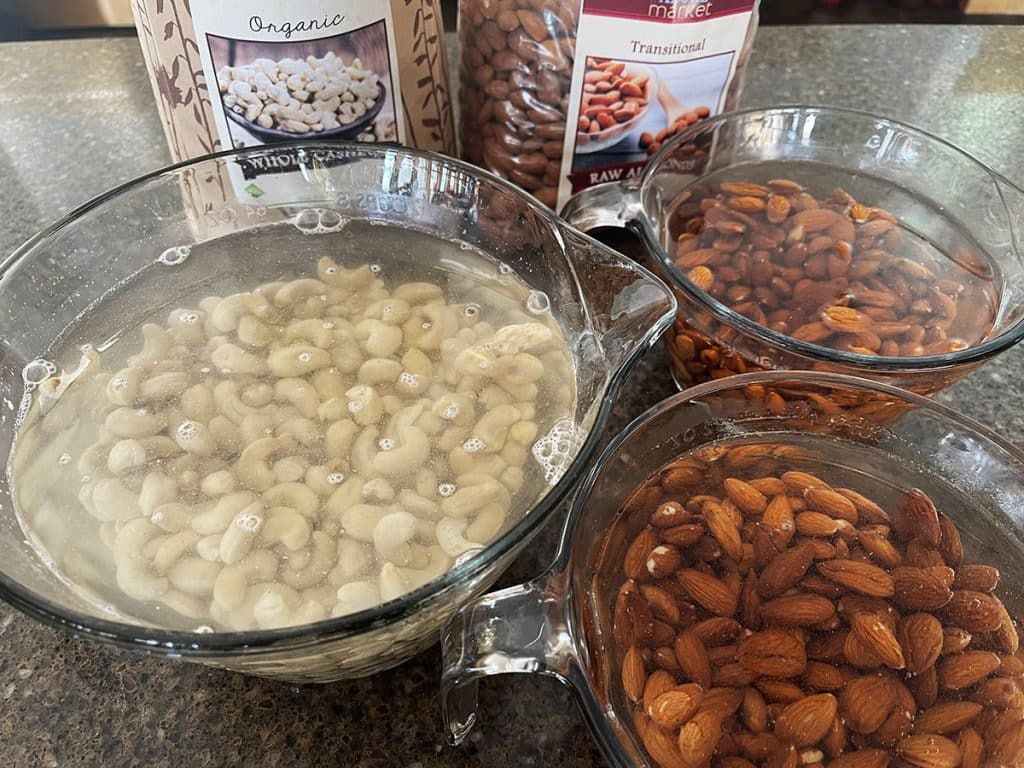
This is where soaking comes in.
You’ve probably heard that April showers bring May flowers. A rainy spring and plenty of snow runoff is nature’s way of breaking seeds’ dormancy and kicking off growing season. When conditions become warmer and moist, the enzyme phytase is activated in the seed and it releases nutrients to the embryo so it can begin to germinate. This cascade also triggers the breakdown the seed’s defensive compounds, which are no longer needed post germination.
Gardeners often mimic this by soaking seeds in water to activate phytase and get them ready to plant.
You’re doing the same thing when you soak nuts and seeds in warm salt water for several hours or overnight. They ‘wake up’ and begin to germinate, causing the plant to shut down its defense system, reducing enzyme inhibitors, activating digestive enzymes, and neutralizing phytic acid and other antinutrients.
Making soaked “crispy nuts” a la Nourishing Traditions is not difficult, but it does take intention and a bit of extra planning. It doesn’t take much effort at all to dump a bag of raw almonds into a bowl with some salt water. The trick is in the timing. Some nuts need 7+ hours, while others have an especially high fat content and don’t take long at all.
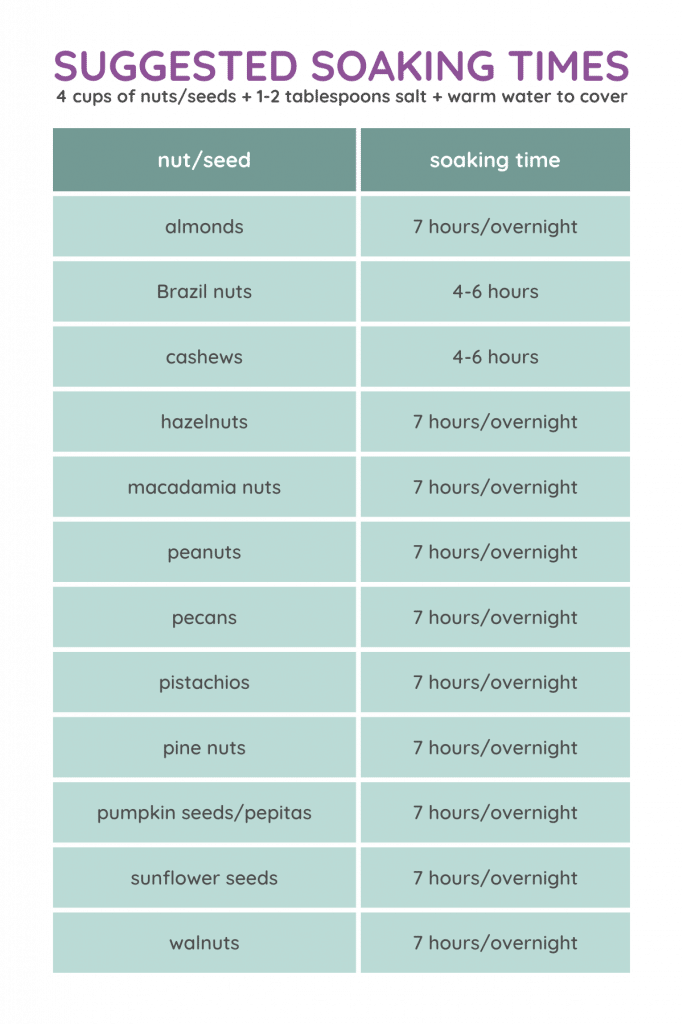
The longer soaking times can be done overnight or while you’re at work. Be sure to set a timer, especially for the shorter soak times. You don’t need to be religious about the exact timing, but soaking soft nuts like cashews for much longer than the recommended 4-6 hours can lead to slimy, bad tasting nuts.
After soaking, the next step is to dehydrate the nuts to restore their crispy texture and to prevent them from spoiling. This can be done by spreading the nuts out on a baking sheet and drying them in a dehydrator or oven for several hours, until they are completely dry and crispy. Keeping the temperature below 115F ensures that no nutrients and beneficial enzymes are destroyed by the heat.
Most ovens don’t go below 200F, so if yours doesn’t have a “warm” setting and you don’t have access to a dehydrator, don’t sweat it. Dehydrate your nuts in the oven at its lowest temperature and crack the door to lower the temperature a bit further. Soaked nuts dried at 200F are still preferable to eating them unsoaked.
For every 4 cups of raw seeds or nuts, add approximately 1 tablespoon of salt and cover with warm, filtered water, plus an additional 2-3” to allow for swelling. The salt acts as both a preservative and a flavoring agent and also plays a role in deactivating enzyme inhibitors. 1 tablespoon will result in mildly salty nuts, but you can increase the salt if you prefer a saltier flavor.
When the time it up, drain the nuts and rinse them under clean running water. Toss them with a bit more salt if desired and spread them in a single layer on large baking pans, cookie sheets or the trays of your dehydrator.
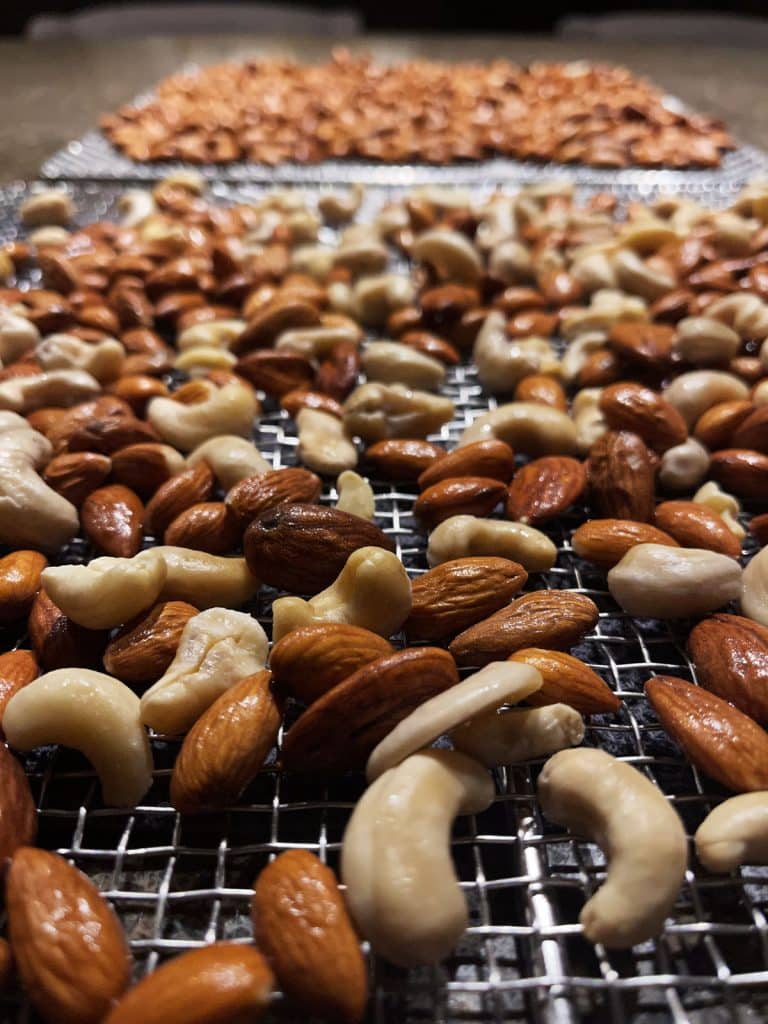
Making the time to properly prepare the nuts and seeds by soaking and/or sprouting them, breaks down the natural barriers that protect the nut or seed from pests, mold and other environmental factors. It also preserves their nutritional value and enhances their flavor.
But what if I really can’t find time to do all this?
Small amounts of roasted, unsoaked nuts and seeds eaten occasionally will probably not bother most people. But seeds and nuts eaten regularly or in any significant quantity should be soaked. And if you have autoimmune issues, leaky gut or any kind of digestive disorder, then it will become even more important for you to pay attention to this stuff.
Honestly, I don’t bother soaking most small seeds. There are a few seeds that we eat regularly that are listed above with a suggested soaking time, but I really don’t think we eat enough poppy seeds to bother.
Flax and chia seeds gel on contact with water, making them difficult to soak and dehydrate. There are ways to ferment the chia/flax gel to reduce the phytic acid load, but this isn’t something I typically mess with and instead opt to use flax and chia seeds sparingly.
For sesame seeds, we purchase only hulled seeds (the hull is where most of the antinutrients are concentrated) and eat them sparingly as a garnish. The roasting process further reduces the phytate load, so roasted/toasted and hulled sesame seeds are probably your best bet.
If you need a shortcut to soaked/sprouted nuts, there are a number of products out there that are great. Azure Standard carries a variety of sprouted nuts by Lark Ellen Farm. They are a little on the expensive side, but you can get better prices by buying in bulk.
Of course, there are a bunch of different brands to be had via Amazon.
Thrive Market’s store brand has reasonably priced organic sprouted almonds, cashews, walnuts, pumpkin seeds and sunflower seeds.
If you can eat peanuts, Trader Joe’s has Old Fashioned Blister Peanuts that have been soaked in water before roasting. These are surprisingly affordable and probably the best value of the bunch.
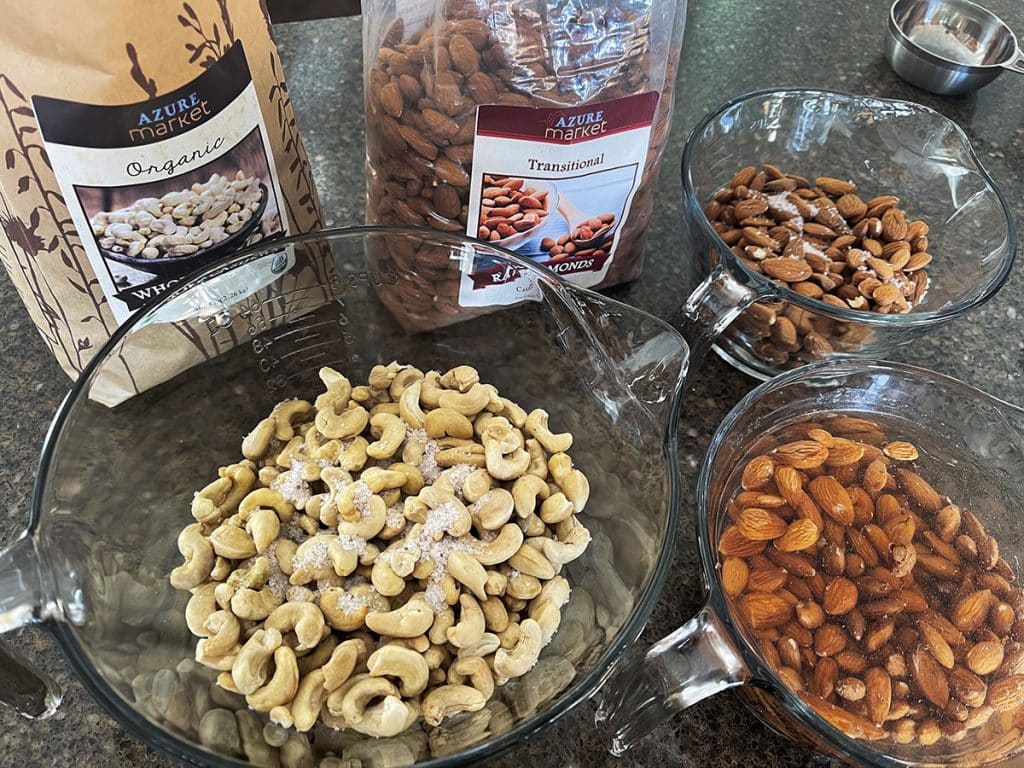
Have you made crispy nuts? What’s your favorite spice combination?
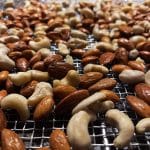
Crispy Nuts
5 Stars 4 Stars 3 Stars 2 Stars 1 Star
No reviews
Instructions
- In a large mixing bowl, cover nuts/seeds with enough warm water to submerge them by 2″ or 3″.
- Add salt and stir until salt has dissolved.
- Allow nuts to soak in the salt water at room temperature for the appropriate amount of time (see chart above for reference).
- Strain soaked nuts/seeds into a large colander.
- Toss with a bit more salt if desired (very fine salt sticks better than coarser salts) and spread nuts/seeds in a single layer on large baking pans, cookie sheets or the trays of your dehydrator.
- Dehydrate at 115F or in a warm oven at its lowest temperature with the door ajar for 12 to 24 hours, turning occasionally until the nuts/seeds are completely dry and crisp.
- Store in an airtight container.
Notes
Flavor your crispy nuts! Prior to dehydrating, you can also choose to toss the nuts in dry spices such as black pepper, cayenne, garlic, cinnamon, etc. You can also try adding soy sauce, coconut aminos, Worcestershire sauce, maple syrup or a bit of hot sauce to the brine water to impart extra flavor.

